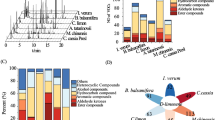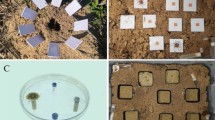Abstract
The red imported fire ant is one of the world’s most devastating invasive species, adversely affecting humans, wildlife, crops, and livestock. To control infestations, chemical pesticides are deployed extensively around the world. However, their extensive use has led to negative effects on the environment and human health. Essential oils, which are safe and ecofriendly, can potentially be used as alternatives to chemical pesticides. In this study, grapefruit essential oils were used as fumigant agents to control red imported fire ants. The crude grapefruit oil (GO1) contained 28 compounds, and the concentrated grapefruit oil (GO2), which was refined from GO1 by vacuum distillation, contained 20 compounds. D-Limonene was the dominant constituent in both GO1 (70.1%) and GO2 (73.96%), and other important constituents included β-pinene, α-pinene, β-phellandrene, octanal, d-carvone, α-terpineol, and linalool. Both the essential oils and their individual constituents (α-pinene, α-terpineol, β-phellandrene, octanal, and d-carvone) showed strong lethal fumigant effects against workers. Workers were more susceptible to GO2 than GO1, and octanal was more toxic to workers as compared with the other four constituents. When antennas of workers were treated with the two oils or the five constituents, their walking and gripping abilities were significantly suppressed, and there was an obvious bending or breaking phenomenon on the sensilla of the antennas. Fumigant activity by grapefruit essential oils and their main compounds were associated with their effects on the walking and gripping behavior of workers, and this confirmed that grapefruit essential oil is a promising, ecofriendly, and safe fumigant for the control of red imported fire ants.




Similar content being viewed by others
Data availability
The datasets used and/or analyzed during the current study are available from the corresponding author on reasonable request.
References
Abad MKR, Besheli BA (2016) Insecticidal potential of essential oil from the leaves of Citrus aurantium L. against Oryzaephilus surinamensis (F.), Lasioderma serricorne (L.) and Sitophilus oryzae (L.). J Entomol Zool Stud 4:865–869
Amorim JL, Simas DLR, Pinheiro MMG, Moreno DSA, Alviano CS, Da Silva AJR, Dias Fernandes P (2016) Anti-inflammatory properties and chemical characterization of the essential oils of four citrus species. PLoS One 11:e0153643
Ascunce MS, Yang C, Oakey J, Calcaterra L, Wu W, Shih C, Goudet J, Ross KG, Shoemaker D (2011) Global invasion history of the fire ant Solenopsis invicta. Sci 331:1066–1068
Bakkali F, Averbeck S, Averbeck D, Idaomar M (2008) Biological effects of essential oils – a review. Food Chem Toxicol 46:446–475
Bilal H, Akram W, Hassan SA, Zia A, Bhatti AR, Mastoi MI, Aslam S (2015) Insecticidal and repellent potential of citrus essential oils against Tribolium castaneum Herbst (Coleoptera: Tenebrionidae). Pak J Zool 47:997–1002
Chaudhari AK, Singh VK, Kedia A, Das S, Dubey NK (2021) Essential oils and their bioactive compounds as eco-friendly novel green pesticides for management of storage insect pests: prospects and retrospects. Environ Sci Pollut Res 28:18918–18940. https://doi.org/10.1007/s11356-021-12841-w
Chen J (2016) Toxicity and efficacy of two emulsifiable concentrates of 2-tridecanone against red imported fire ants. Adv Entomol 4:37–46
Chen H, Akinkurolere RO, Zhang H (2011) Fumigant activity of plant essential oil from Armoracia rusticana (L.) on Plodia interpunctella (Lepidoptera: Pyralidae) and Sitophilus zeamais (Coleoptera: Curculionidae). Afr J Biotechnol 10:1200–1205
Collins L, Scheffrahn RH (2016) Red imported fire ant, Solenopsis invicta Buren (Insecta: Hymenoptera: Formicidae: Myrmicinae). Entomology and Nematology Department, UF/IFAS Extension 195:1–10
Deng W, Liu K, Cao S, Sun J, Zhong B, Chun J (2020) Chemical composition, antimicrobial, antioxidant, and antiproliferative properties of grapefruit essential oil prepared by molecular distillation. Molecules 25:217. https://doi.org/10.3390/molecules25010217
Flamini G, Cioni PL (2010) Odour gradients and patterns in volatile emission of different plant parts and developing fruits of grapefruit (Citrus paradisi L.). Food Chem 120:984–992
Freires I, Denny C, Benso B, de Alencar S, Rosalen P (2015) Antibacterial activity of essential oils and their isolated constituents against cariogenic bacteria: a systematic review. Molecules 20:7329–7358
Fu JT, Tang L, Li WS, Wang K, Cheng DM, Zhang ZX (2015) Fumigant toxicity and repellence activity of camphor essential oil from Cinnamonum camphora Siebold against Solenopsis invicta workers (Hymenoptera:Formicidae). J Insect Sci 15:129
Hu W, Zhang N, Chen HL, Zhong BL, Yang AX, Kuang F, Ouyang ZG, Chun J (2017) Fumigant activity of sweet orange essential oil fractions against red imported fire ants (Hymenoptera: Formicidae). J Econ Entomol 110:1556–1562
Huang YT, Chen SQ, Li ZQ, Wang L, Xu YJ (2018a) Effects of flavor enhancers on the survival and behavior of the red imported fire ant, Solenopsis invicta (Hymenoptera: Formicidae). Environ Sci Pollut Res 25:21879–21886
Huang X, Ge SY, Liu JH, Wang Y, Liang XY, Yuan HB (2018b) Chemical composition and bioactivity of the essential oil from Artemisia lavandulaefolia (Asteraceae) on Plutella xylostella (Lepidoptera: Plutellidae). Fla Entomol 101:44–48
Ivoke N, Ogbonna PC, Ekeh FN, Ezenwaji NE, Atama CI, Ejere VC, Onoja US, Eyo JE (2013) Effects of grapefruit (Citrus paradisi Macf) (Rutaceae) peel oil against developmental stages of Aedes aegypti (Diptera: Culicidae). Se Asian J Trop Med 44:970–978
Kahraman T, Issa G, Altunatmaz SS, Kahraman BB, Aksu F, Aydin A, Aksu H (2016) Effects of oregano essential oil, grapefruit seed extract and their combination on the growth and survival of Salmonella Typhimurium and Listeria monocytogenes in poultry fillets under modified atmosphere packaging. Slov Vet Res 53:5–12
Lou Z, Chen J, Yu F, Wang H, Kou X, Ma C, Zhu S (2017) The antioxidant, antibacterial, antibiofilm activity of essential oil from Citrus medica L. var. sarcodactylis and its nanoemulsion. Lwt-Food Sci Technol 80:371–377
Matasyoh JC, Kiplimo JJ, Karubiu NM, Hailstorks TP (2007) Chemical composition and antimicrobial activity of essential oil of Tarchonanthus camphoratus. Food Chem 101:1183–1187
Messgo-Moumene S, Li Y, Bachir K, Houmani Z, Bouznad Z, Chemat F (2015) Antifungal power of citrus essential oils against potato late blight causative agent. J Essent Oil Res 27:169–176
Njoroge SM, Koaze H, Karanja PN, Sawamura M (2005) Volatile constituents of redblush grapefruit (Citrus paradisi) and pummelo (Citrus grandis) peel essential oils from Kenya. J Agric Food Chem 53:9790–9794
Pan F, Lu Y, Wang L (2015) Toxicity and sublethal effects of sulfoxaflor on the red imported fire ant, Solenopsis invicta. Ecotox Environ Saf 139:377–383
Pavela R (2014) Insecticidal properties of Pimpinella anisum essential oils against the Culex quinquefasciatus and the non-target organism Daphnia magna. J Asia Pac Entomol 17:287–293
Pino J, Sánchez M (2000) Chemical composition of grapefruit oil concentrates. J Essent Oil Res 12:167–169
Pinto E, Gonçalves M, Cavaleiro C, Salgueiro L (2017) Antifungal activity of Thapsia villosa essential oil against Candida, Cryptococcus, Malassezia, Aspergillus and dermatophyte species. Molecules 22:1595
Qin DQ, Zhang PW, Zhou Y, Liu B, Xiao CX, Chen WB, Zhang ZX (2020) Antifeeding effects of azadirachtin on the fifth instar Spodoptera litura larvae and the analysis of azadirachtin on target sensilla around mouthparts. Arch Insect Biochem Physiol 103:5318
Renthal R, Velasquez D, Olmos D, Hampton J, Wergin WP (2003) Structure and distribution of antennal sensilla of the red imported fire ant. Micron 34:405–413
Rizvi SAH, Ling S, Tian F, Xie F, Zeng XN (2018) Toxicity and enzyme inhibition activities of the essential oil and dominant constituents derived from Artemisia absinthium L. against adult Asian citrus psyllid Diaphorina citri Kuwayama (Hemiptera: Psyllidae). Ind Crop Prod 121:468–475
Silverio MS, Del-Vechio-Vieira G, Pinto MAO, Alves MS, Sousa OV (2013) Chemical composition and biological activities of essential oils of Eremanthus erythropappus (DC) McLeisch (Asteraceae). Molecules 18:9785–9796
Souto RNP, Harada AY, Andrade EHA, Maia JGS (2012) Insecticidal activity of piper essential oils from the amazon against the fire ant Solenopsis saevissima (Smith) (Hymenoptera: Formicidae). Neotrop Entomol 41:510–517
Suthisut D, Fields PG, Chandrapatya A (2011) Fumigant toxicity of essential oils from three Thai plants (Zingiberaceae) and their major compounds against Sitophilus zeamais, Tribolium castaneum and two parasitoids. J Stored Prod Res 47:222–230
Tak J, Jovel E, Isman MB (2016) Comparative and synergistic activity of Rosmarinus officinalis L. essential oil constituents against the larvae and an ovarian cell line of the cabbage looper, Trichoplusia ni (Lepidoptera: Noctuidae). Pest Manag Sci 72:474–480
Tang L, Sun YY, Zhang QP, Zhou Y, Zhang N, Zhang ZX (2013) Fumigant activity of eight plant essential oils against workers of red imported fire ant, Solenopsis invicta. Sociobiology 60:35–40
Tao N, Liu Y, Zhang M (2009) Chemical composition and antimicrobial activities of essential oil from the peel of bingtang sweet orange (Citrus sinensis Osbeck). Int J Food Sci Technol 44:1281–1285
Uysal B, Sozmen F, Aktas O, Oksal BS, Kose EO (2011) Essential oil composition and antibacterial activity of the grapefruit (Citrus Paradisi. L) peel essential oils obtained by solvent-free microwave extraction: comparison with hydrodistillation. Int J Food Sci Technol 46:1455–1461
Wang C, Henderson G (2016) Repellent effect of formic acid against the red imported fire ant (Hymenoptera: Formicidae): a field study. J Econ Entomol 109:779–784
Wang L, Zeng L, Chen J (2015) Sublethal effect of imidacloprid on Solenopsis invicta (Hymenoptera: Formicidae) feeding, digging, and foraging behavior. Environ Entomol 44:1544–1552
Xu Y, Huang J, Zhou A, Zeng L (2012) Prevalence of Solenopsis invicta (Hymenoptera: Formicidae) venom allergic reactions in mainland China. Fla Entomol 95:961–965
Yoon C, Kang S, Jang S, Yjm Y, Kim G (2007) Repellent efficacy of caraway and grapefruit oils for Sitophilus oryzae (Coleoptera: Curculionidae). J Asia Pac Entomol 10:263–267
Zaka SM, Iqbal N, Saeed Q, Akrem A, Batool M, Khan AA, Anwar A, Bibi M, Azeem S, Rizvi D, Bibi R, Khan KA, Ghramh HA, Ansari MJ, Latif S (2019) Toxic effects of some insecticides, herbicides, and plant essential oils against Tribolium confusum Jacquelin du val (Insecta: Coleoptera: Tenebrionidae). Saudi J Biol Sci 26:1767–1771
Zettler JA, Spira TP, Allen CR (2001) Ant-seed mutualisms: can red imported fire ants sour the relationship? Biol Conserv 101:249–253
Zhang R, Li Y, Liu N, Porter SD (2007) An overview of the red imported fire ant (Hymenoptera: Formicidae) in mainland China. Fla Entomol 90:723–731
Zhang N, Tang L, Hu W, Wang K, Zhou Y, Li H, Huang CL, Chun J, Zhang ZX (2014) Insecticidal, fumigant, and repellent activities of sweet wormwood oil and its individual components against red imported fire ant workers (Hymenoptera: Formicidae). J Insect Sci 14:536–541
Funding
This study was supported by the National Natural Science Foundation of China (32001967), the Jiangxi Province Natural Science Foundation (20202BABL215007), the Foundation of Jiangxi Province Educational Committee (GJJ190760), the Program of Science and Technology Planning Project of Ganzhou ([2020]60 and [2019]60), the University Students’ Innovative Undertaking of Gannan Normal University (CX190015), and the Program of Science and Technology Planning Project of Xichang ([2020]209).
Author information
Authors and Affiliations
Contributions
Ning Zhang analyzed the data and wrote the manuscript. Yihong Liao and Lianjie Xie performed the experiments. Zhixiang Zhang and Wei Hu gave the direction of research and reviewed the manuscript. Fan Kuang revised the manuscript.
Corresponding authors
Ethics declarations
Conflict of interest
The authors declare no competing interests.
Additional information
Responsible Editor: Lotfi Aleya
Publisher’s note
Springer Nature remains neutral with regard to jurisdictional claims in published maps and institutional affiliations.
Rights and permissions
About this article
Cite this article
Zhang, N., Liao, Y., Xie, L. et al. Using essential oils from Citrus paradisi as a fumigant for Solenopsis invicta workers and evaluating the oils’ effect on worker behavior. Environ Sci Pollut Res 28, 59665–59672 (2021). https://doi.org/10.1007/s11356-021-14910-6
Received:
Accepted:
Published:
Issue Date:
DOI: https://doi.org/10.1007/s11356-021-14910-6




